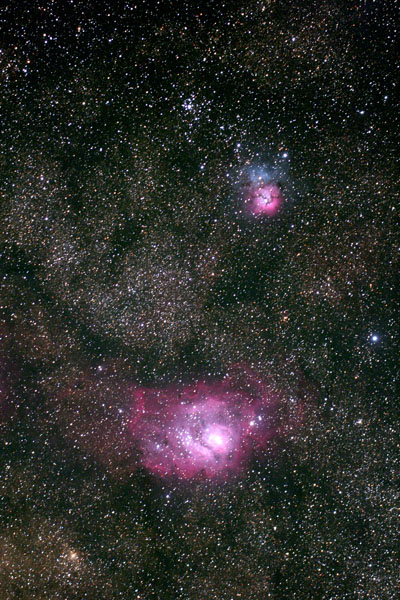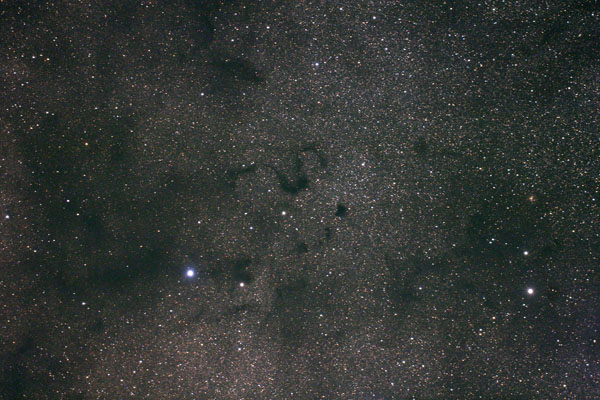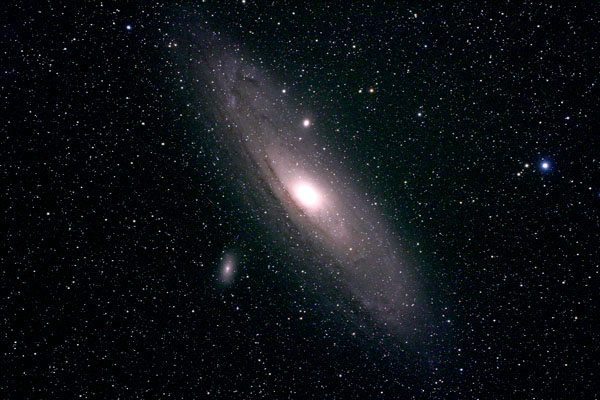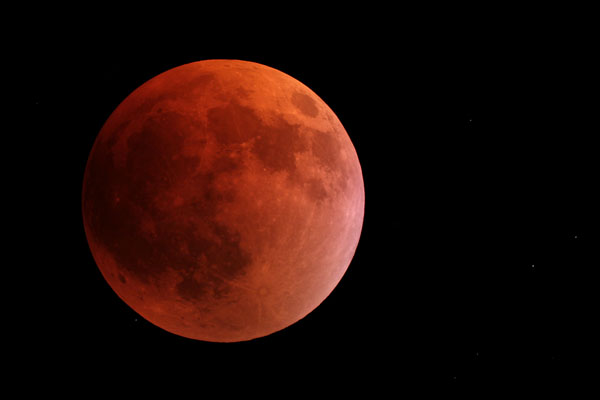The new digital SLR cameras make surprisingly good astrophtography cameras on bright objects. This was true enough that Canon produced a version of their 8 megapixel 20D specifically for the astrophotograpy market, the Canon 20Da. The camera has a few modifications needed to make it much more usable for astro work including a re-tuned IR cutoff filter and some special focusing modes. Below are examples of the 20Da in action using a relatively small 76mm (3 inch) telescope. Easy to set up, easy to use, the camera provides a capable astrophoto platform with much less work in a portable package.
Omega Centuari
One of the most spectacular deep sky sights are the big globulars with NGC5139 being the biggest of all. A spectacular swarm of stars in a mind bogglingly tight ball.
Canon 20Da DSLR camera mounted on a Televue-76 APO telescope with a 0.8x focal reducer/field flattener. Single 2 minute exposure at ISO 800. Taken at Casitas de Gila, outside of Silver City, New Mexico.

 The Eagle and the Swan
The Eagle and the Swan
Along what I call 'Nebula Row' in Sagittarius are the two great star nurseries of M16 and M17. Beautiful sights in the telescope and great photographic targets.
Canon 20Da DSLR camera mounted on a Televue-76 APO telescope with a 0.8x focal reducer/field flattener. Single 8 minute exposure at ISO 800. Taken at Casitas de Gila, outside of Silver City, New Mexico.
 The Lagoon and Trifid
The Lagoon and Trifid
At the lower end of Nebula Row is the large Lagoon Nebula, another star birth nebula with innumerable stars sprinkled across it. Above it the iconic Trifid Nebula a beautiful combination of red emission and blue reflection nebula.
Visible in this photo are M8, M20, M21, NGC6544, NGC6553, B88, B89, B91, B303, IC4685 and IC1274.
Canon 20Da DSLR camera mounted on a Televue-76 APO telescope with a 0.8x focal reducer/field flattener. Single 8 minute exposure at ISO 800. Taken at Casitas de Gila, outside of Silver City, New Mexico.
Baade's Window
Just above the spout of the 'Teapot' of Sagittarius is a bright cloud of stars well known to stargazers. This area is of particular interest to astronomers as well. The area is relatively free of dust clouds and provides an almost unobstructed view into the vast star clouds at the center of our Milky Way galaxy.
Visible in this photo are NGC6522, NGC6528, B289, and B298.
Canon 20Da DSLR camera mounted on a Televue-76 APO telescope with a 0.8x focal reducer/field flattener. Single 8 minute exposure at ISO 800. Taken at Casitas de Gila, outside of Silver City, New Mexico.

The Snake
The center of our galaxy is a mass of stars and dark clouds of dust. When the dust obscures the stars we can see the enigmatic dark nebula silhouetted against the stellar background.
Visible in this photo are B72, NGC6369, B68, B69, B70, B71, and many others.
Canon 20Da DSLR camera mounted on a Televue-76 APO telescope with a 0.8x focal reducer/field flattener. Single 8 minute exposure at ISO 800. Taken at Casitas de Gila, outside of Silver City, New Mexico.

Andromeda Galaxy
One of he most distant objects visible to the naked eye is our sister galaxy M31. Together M31 with M33, our own Milky Way and about 30 odd small dwarf galaxies make up the local group.
Visible in this photo are M31, M32 and M110.
Canon 20Da DSLR camera mounted on a Televue-76 APO telescope with a 0.8x focal reducer/field flattener. Single 8 minute exposure at ISO 800. Taken at Casitas de Gila, outside of Silver City, New Mexico.

Total Lunar Eclipse
A total lunar eclipse on the night of August 27-28, 2007 with the Moon deep in the Earth's inner shadow. A dark eclipse, this exposure shows a number of stars surrounding the Moon.
Canon 20Da DSLR camera mounted on a 90mm APO f/12 telescope with a 0.8x focal reducer/field flattener. Single 30sec exposure at ISO 200. Taken at Hale Pohaku, Mauna Kea, Hawaii
